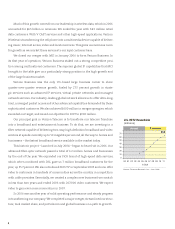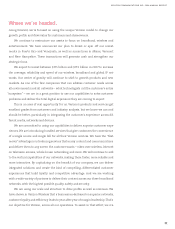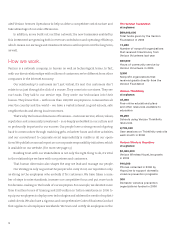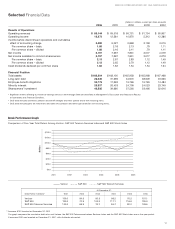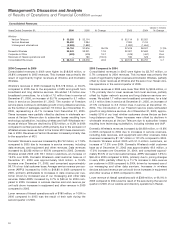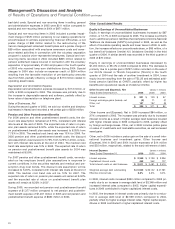Verizon Wireless 2006 Annual Report Download - page 20
Download and view the complete annual report
Please find page 20 of the 2006 Verizon Wireless annual report below. You can navigate through the pages in the report by either clicking on the pages listed below, or by using the keyword search tool below to find specific information within the annual report.
FiOS network, we expect to realize savings in annual, ongoing
operating expenses as a result of efficiencies gained from fiber
network facilities. As the deployment of the FiOS network gains
scale and installation automation improvements occur, costs per
home connected are expected to decline. Since the merger with
MCI, we have gained operational benefits from sales force and
product and systems integration initiatives. While workforce
levels in 2006 increased to 242,000 from 206,000 primarily as a
result of the acquisition of MCI, productivity improvements and
merger synergy savings led to headcount reductions of about
9,200 in our wireline business.
•Capital Allocation – Our capital spending continues to be directed
toward growth markets. High-speed wireless data (Evolution-
Data Optimized, or EV-DO) services, replacement of copper
access lines with fiber optics to the premises, as well as
expanded services to business markets are examples of areas of
capital spending in support of these growth markets. Excluding
discontinued operations, in 2006, capital expenditures were
$17,101 million compared to 2005 capital expenditures of
$14,964 million. Of the increase, $1,602 million was primarily
attributable to capital spending related to the former MCI, with
the remainder in support of growth initiatives. In 2007, Verizon
management expects capital expenditures to be in the range of
$17.5 billion to $17.9 billion. In addition to capital expenditures,
Verizon Wireless continues to participate in the Federal
Communications Commission’s (FCC) wireless spectrum auc-
tions and continues to evaluate spectrum acquisitions in support
of expanding data applications and its growing customer base. In
2006, this included participation in the FCC Auction 66 of
Advanced Wireless Services spectrum (AWS auction) in which
Verizon Wireless was the high bidder on thirteen 20 MHz licenses
covering a population of nearly 200 million.
•Cash Flow Generation and Shareowner Value Creation – The
financial statements reflect the emphasis of management on not
only directing resources to growth markets, but also creating
value for shareowners through the use of cash provided by our
operating and investing activities for the repayment of debt, share
repurchases and providing a stable dividend to our shareowners,
in addition to returning value to shareowners through spin-off and
other strategic transactions. Verizon’s total debt decreased to
$36,361 million as of December 31, 2006 from $38,257 million as
of December 31, 2005, primarily as a result of the debt reduction
resulting from the spin-off of Idearc Inc. (Idearc), formerly our U.S.
print and Internet yellow pages directories business, and the use
of cash acquired in the MCI merger and generated through
strategic asset sales (see “Other Factors That May Affect Future
Results – Recent Developments”), partially offset by debt
acquired in connection with the MCI merger. Strategic asset sales
included the sale of Verizon Dominicana C. por A. (Verizon
Dominicana), which closed on December 1, 2006. Verizon’s ratio
of debt to debt combined with shareowners’ equity was 42.8% as
of December 31, 2006 compared with 49.1% as of December 31,
2005. Management has recommended to the Board of Directors
that our dividend be maintained at a level no less than that imme-
diately preceding the Idearc spin-off. In addition, we repurchased
$1,700 million of our common stock as part of our previously
announced program during 2006, and we plan to continue our
share buyback program at similar levels in 2007. Additionally,
Verizon’s balance of cash and cash equivalents at December 31,
2006 of $3,219 million increased by $2,459 million from $760 mil-
lion at December 31, 2005.
OVERVIEW
Verizon Communications Inc. (Verizon) is one of the world’s leading
providers of communications services. Verizon’s wireline business,
which includes the operations of the former MCI, provides telephone
services, including voice, broadband data and video services, net-
work access, nationwide long-distance and other communications
products and services, and also owns and operates one of the most
expansive end-to-end global Internet Protocol (IP) networks.
Verizon’s domestic wireless business, operating as Verizon Wireless,
provides wireless voice and data products and services across the
United States using one of the most extensive and reliable wireless
networks. Stressing diversity and commitment to the communities in
which we operate, Verizon has a highly diverse workforce of approx-
imately 242,000 employees.
The sections that follow provide information about the important
aspects of our operations and investments, both at the consolidated
and segment levels, and include discussions of our results of opera-
tions, financial position and sources and uses of cash. In addition, we
have highlighted key trends and uncertainties to the extent practi-
cable. The content and organization of the financial and non-financial
data presented in these sections are consistent with information used
by our chief operating decision makers for, among other purposes,
evaluating performance and allocating resources. We also monitor
several key economic indicators as well as the state of the economy
in general, primarily in the United States where the majority of our
operations are located, in evaluating our operating results and ana-
lyzing and understanding business trends. While most key economic
indicators, including gross domestic product, impact our operations
to some degree, we have noted higher correlations to housing starts,
non-farm employment, personal consumption expenditures and cap-
ital spending, as well as more general economic indicators such as
inflation and unemployment rates.
Our results of operations, financial position and sources and uses of
cash in the current and future periods reflect Verizon management’s
focus on the following four key areas:
•Revenue Growth – Our emphasis is on revenue growth, devoting
more resources to higher growth markets such as wireless,
including wireless data, wireline broadband connections,
including fiber optics to the premises (Verizon’s FiOS data and TV
services), digital subscriber lines (DSL) and other data services,
long distance, as well as expanded strategic services to business
markets, rather than to the traditional wireline voice market,
where we have been experiencing access line losses. Verizon
reported consolidated revenue growth of 26.8% in 2006 com-
pared to 2005, primarily driven by the merger with MCI and
17.8% higher revenue at Domestic Wireless. Verizon added
7,715,000 wireless customers and 1,838,000 broadband connec-
tions in 2006.
•Operational Efficiency – While focusing resources on growth, we
are continually challenging our management team to lower
expenses, particularly through technology-assisted productivity
improvements including self-service initiatives. The effect of
these and other efforts, such as real estate consolidations, call
center routing improvements and the formation of Verizon
Services Organization, has been to change the company’s cost
structure and maintain stable operating income margins. Real
estate consolidations include the establishment of the Verizon
Center. The Verizon Services Organization provides centralized
services across our business, including procurement, finance
operations and real estate services. With our deployment of the
18
Management’s Discussion and Analysis
of Results of Operations and Financial Condition
VERIZON COMMUNICATIONS INC. AND SUBSIDIARIES


